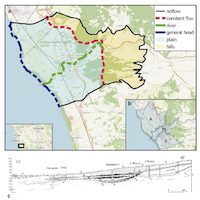Original Papers
Vol. 10 No. 3 (2021)
Time series analysis for water resources management - application to observed and simulated time-series of the groundwater flow numerical model of the coastal plain of Cecina

Publisher's note
All claims expressed in this article are solely those of the authors and do not necessarily represent those of their affiliated organizations, or those of the publisher, the editors and the reviewers. Any product that may be evaluated in this article or claim that may be made by its manufacturer is not guaranteed or endorsed by the publisher.
All claims expressed in this article are solely those of the authors and do not necessarily represent those of their affiliated organizations, or those of the publisher, the editors and the reviewers. Any product that may be evaluated in this article or claim that may be made by its manufacturer is not guaranteed or endorsed by the publisher.
Received: 6 September 2021
Accepted: 24 September 2021
Accepted: 24 September 2021
862
Views
447
Downloads









